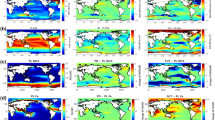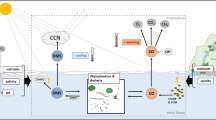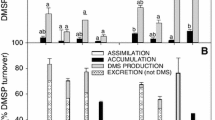Abstract
The ubiquitous, biogenic trace gas dimethylsulfide (DMS) represents the largest natural source of atmospheric sulfur. Given DMS involvement in cloud formation and climate, understanding and parameterizing the oceanic DMS source and cycling processes is a necessary challenge. We report DMS cycling rates from microzooplankton dilution grazing experiments conducted monthly during 1 year in coastal northwestern Mediterranean waters. Concentrations of DMS, its algal precursor dimethylsulfoniopropionate (DMSPt) and chlorophyll a (Chla) ranged 0.9–11 nmol L−1, 10–71 nmol L−1, and 0.2–1.5 µg L−1, respectively. By comparing the growth and stock production rates of the DMSP-producing algae to those of total phytoplankton, we estimated that 3 ± 4% (range 0.4–12%) of the carbon primary production was invested in DMSP biosynthesis. Microzooplankton grazing rates on DMSP-producing phytoplankton (0.46–1.45 day−1) were generally higher than those on the bulk assemblage (0.08–0.99 day−1), except in midsummer months. This could have been due to the smaller size of most DMSP producers. There was no indication of micrograzer selection against DMSP-containing phytoplankton, since they were not grazed at lower rates than the bulk phytoplankton assemblage. A proportion of 6–20% of the grazed DMSP was converted into DMS, and this grazing-derived production accounted for 32–96% of dark gross DMS production by the total community. Bacteria consumed daily ≤ 14–100% of the gross DMS production, which resulted in biological DMS turnover times of 1 to ≥ 10 days. Throughout the year, grazing-mediated DMS production explained 73% of the variance in the DMS concentration, implying that microzooplankton grazing plays a major role in controlling DMS concentration in surface waters across a broad range of environmental and productivity conditions in the Mediterranean Sea. These findings should help improve the representation of herbivore grazing in prognostic models to predict the distribution and dynamics of the global DMS emission and its feedback response to changing climate.




Similar content being viewed by others
References
Andersen T, Schartau AKL, Paasche E (1991) Quantifying external and internal nitrogen and phosphorus pools, as well as nitrogen and phosphorous supplied through remineralisation, in coastal marine plankton by means of a dilution technique. Mar Ecol Prog Ser 69:67–80
Archer SD, Stelfox-Widdicombe CE, Burkill PH, Malin G (2001a) A dilution approach to quantify the production of dissolved dimethylsulphoniopropionate and dimethyl sulphide due to microzooplankton herbivory. Aquat Microb Ecol 23:131–145
Archer SD, Widdicombe CE, Tarran GA, Rees AP, Burkill P (2001b) Production and turnover of particulate dimethylsulphoniopropionate during a coccolithophore bloom in the northern North Sea. Aquat Microb Ecol 24:225–241
Archer SD, Stelfox-Widdicombe CE, Malin G, Burkill PH (2003) Is dimethyl sulphide production related to microzooplankton herbivory in the southern North Sea? J Plankton Res 25:235–242
Archer SD, Cummings DG, Llewellyn CA, Fishwick JR (2009) Phytoplankton taxa, irradiance and nutrient availability determine the seasonal cycle of DMSP in temperate shelf seas. Mar Ecol Prog Ser 394:111–124
Archer SD, Safi K, Hall A, Cummings DG, Harvey M (2011) Grazing suppression of dimethylsulphoniopropionate (DMSP) accumulation in iron-fertilised, sub-Antarctic waters. Deep Sea Res Part II 58:839–850
Atienza D, Calbet A, Saiz E, Alcaraz M, Trepat I (2006) Trophic impact, metabolism, and biogeochemical role of the marine cladoceran Penilia avirostris and the co-dominant copepod Oithona nana in NW Mediterranean coastal waters. Mar Biol 150:221–235
Belviso S, Christaki U, Vidussi F, Marty JC, Vila M, Delgado M (1993) Size distribution of dimethisulfoniopropionate (DMSP) in areas of the tropical northeastern Atlantic Ocean and the Mediterranean Sea. Mar Chem 44:55–71
Børsheim KY, Bratbak G (1987) Cell volume to cell carbon conversion factors for a bacterivorous Monas sp. enriched from seawater. Mar Ecol Prog Ser 36:171–175
Calbet A, Landry MR (2004) Phytoplankton growth, microzooplankton grazing, and carbon cycling in marine systems. Limnol Oceanogr 49:51–57
Calbet A, Trepat I, Almeda R, Saló V, Saiz E, Movilla JI, Alcaraz M, Yebra L, Simó R (2008) Impact of micro- and nanograzers on phytoplankton assessed by standard and size-fractionated dilution experiments. Aquat Microb Ecol 50:145–156
Carpenter LJ, Archer SD, Beale R (2012) Ocean-atmosphere trace gas exchange. Chem Soc Rev 41:6473–6505
Charlson RJ, Lovelock JE, Andreae MO, Warren SG (1987) Oceanic phytoplankton, atmospheric sulphur, cloud albedo and climate. Nature 326:655–661
Christaki U, Belviso S, Dolan JR, Corn M (1996) Assessment of the role of copepods and ciliates in the release to solution of particulate DMSP. Mar Ecol Prog Ser 141:119–127
Dacey JWH, Wakeham SG (1986) Oceanic dimethylsulfide: production during zooplankton grazing on phytoplankton. Science 233:1314–1316
Dacey JWH, Howse FA, Michaels AF, Wakeham SG (1998) Temporal variability of dimethylsulfide and dimethylsulfoniopropionate in the Sargaso Sea. Deep Sea Res Part I 45:2085–2104
Daly KL, DiTullio GR (1996) Particulate dimethylsulfoniopropionate removal and dimethylsulfide production by zooplankton in the Southern Ocean. In: Kiene RP, Visscher PT, Keller MD, Kirst GO (eds) Biological and environmental chemistry of DMSP and related sulfonium compounds. Plenum Press, New York, pp 223–238
Davidson K (2014) The challenges of incorporating realistic simulations of marine protists in biogeochemically based mathematical models. Acta Protozool 53:129–138
del Valle DA, Kieber DJ, Toole DA, Brinkley J, Kienea RP (2009) Biological consumption of dimethylsulfide (DMS) and its importance in DMS dynamics in the Ross Sea, Antarctica. Limnol Oceanogr 54(3):785–798
Fencehel T (1980) Suspension feeding in ciliated protozoa: functional response and particle size selection. Microb Ecol 6:1–11
Fredrickson KA, Strom SL (2009) The algal osmolyte DMSP as a microzooplankton grazing deterrent in laboratory and field studies. J Plankton Res 31:135–152
Frost BW (1972) Effects of size and concentration of food particles on the feeding behaviour of the marine planktonic copepod Calanus pacificus. Limnol Oceanogr 17:805–815
Galí M, Simó R (2015) A meta-analysis of oceanic DMS and DMSP cycling processes disentangling the summer paradox. Glob Biogeochem Cycles. https://doi.org/10.1002/2014gb004940
Galí M, Saló V, Almeda R, Calbet A, Simó R (2011) Stimulation of gross dimethylsulfide (DMS) production by solar radiation. Geophys Res Lett 38:L15612. https://doi.org/10.1029/2011GL048051
Galí M, Devred E, Levasseur M, Royer S-J, Babin M (2015) A remote sensing algorithm for planktonic dimethylsulfoniopropionate (DMSP) and an analysis of global patterns. Remote Sensing Environ 171:171–184
Galí M, Kieber DJ, Romera-Castillo C, Kinsey JD, Devred E, Pérez GL, Westby GR, Marrasé C, Babin M, Levasseur M, Duarte C, Agustí S, Simó R (2016) CDOM sources and photobleaching control quantum yields for oceanic DMS photolysis. Environ Sci Technol 50:13361–13370. https://doi.org/10.1021/acs.est.6b04278
Galí M, Levasseur M, Devred E, Simó R, Babin M (2018) Sea-surface dimethylsulfide (DMS) concentration from satellite data at global and regional scales. Biogeoscience 15:3497–3519
Gasol JM, Cardelús C, Morán XAG, Simó R, Massana R, Marrasé C, Vaqué D, Balagué V, Forn I, Sala MM, Pedrós-Alió C, Estrada M (2016) Seasonal patterns in phytoplankton photosynthetic parameters and primary production at a coastal NW Mediterranean site. Sci Mar. https://doi.org/10.3989/scimar.04480.06E
Keller MD, Bellows WK, Guillard RL (1989) Dimethyl sulfide production in marine phytoplankton. In: Saltzman ES, Cooper WJ (eds) Biogenic sulfur in the environment. American Chemical Society, Washington, DC, pp 183–200
Kiene RP, Slezak D (2006) Low dissolved DMSP concentrations in seawater revealed by small-volume gravity filtration and dialysis sampling. Limnol Oceanogr Methods 4:80–95
Kiene RP, Linn LJ, Bruton JA (2000) New and important roles for DMSP in marine microbial communities. J Sea Res 43:209–224
Kwint RLJ, Kramer KJM (1995) Dimethylsulphide production by plankton communities. Mar Ecol Prog Ser 121:227–237
Kwint RLJ, Quist P, Hansen TA, Dijkhuizen L, Kramer KJM (1996) Turnover of dimethylsulfoniopropionate and dimethylsulfide in the marine environment: a mesocosm experiment. Mar Ecol Prog Ser 145:223–232
Lana A, Bell TG, Simó R, Vallina SM, Ballabrera-Poy J, Kettle AJ, Dachs J, Bopp L, Saltzman ES, Stefels J, Johnson JE, Liss PS (2011) An updated climatology of surface dimethlysulfide concentrations and emission fluxes in the global ocean. Glob Biogeochem Cycles 25:GB1004
Landry MR, Hassett RP (1982) Estimating the grazing impact of marine micro-zooplankton. Mar Biol 67:283–288
Laroche D, Vezina AF, Levasseur M, Gosselin M, Stefels J, Keller MD, Matrai PA, Kwint RLJ (1999) DMSP synthesis and exudation in phytoplankton: a modelling approach. Mar Ecol Prog Ser 180:37–49
Le Clainche Y, Vézina A, Levasseur M, Cropp RA, Gunson JR, Vallina SM, Vogt M, Lancelot C, Allen JI, Archer SD, Bopp L, Deal C, Elliott S, Jin M, Malin G, Schoemann V, Simó R, Six KD, Stefels J (2010) A first appraisal of prognostic ocean DMS models and prospects for their usein climate models. Glob Biogeochem Cycles 24:GB3021
Lehrter JC, Pennock JR, McManus GB (1999) Microzooplankton grazing and nitrogen excretion across a surface estuarine-coastal interface. Estuaries 22:113–125
Lizotte M, Levasseur M, Michaud S, Scarratt MG, Merzouk A, Gosselin M, Pommier J, Rivkin RB, Kiene RP (2012) Macroscale patterns of the biological cycling of dimethylsulfoniopropionate (DMSP) and dimethylsulfide (DMS) in the North Atlantic. Biogeochem 110:183–200
Malin G, Wilson WH, Bratbak G, Liss PS, Mann NH (1998) Elevated production of dimethylsulfide resulting from viral infection of cultures of Phaeocystis pouchetii. Limnol Oceanogr 43:1389–1393
Menden-Deuer S, Lessard EJ (2000) Carbon to volume relationships for dinoflagellates, diatoms, and other protist plankton. Limnol Oceanogr 45:569–579
Montagnes DJS, Morgan G, Bissinger JE, Atkinson D, Weisse T (2008) Short-term temperature change may impact freshwa-ter carbon flux: a microbial perspective. Glob Change Biol 14:2823–2838
Neuer S, Franks PJS (1993) Determination of ammonium uptake and regeneration rates using the seawater dilution method. Mar Biol 116:497–505
Nevitt GA (2011) The neuroecology of dimethyl sulfide: a global climate regulator turned marine infochemical. Integr Compar Biol 51:819–825
Park K, Lee K, Shin K, Yang E-J, Hyun B, Kim J-M, Noh J-H, Kim M, Kong B, Choi DH, Choi S-J, Jang P-G, Jeong HJ (2014) Direct Linkage between dimethyl sulfide production and microzooplankton grazing, resulting from prey composition change under high partial pressure of carbon dioxide conditions. Environ Sci Technol 48:4750–4756
Parsons TR, Maita Y, Lalli CM (1984) A manual of chemical and biological methods for sea water analysis. Pergamon, Oxford
Polimene L, Archer SD, Butenschön M, Allen JI (2012) A mechanistic explanation of the Sargasso Sea DMS ‘‘summer paradox’’. Biogeochem 110:243–255
Putt M, Stoecker DK (1989) An experimentally determined carbon: volume ratio for marine “oligotrichous” ciliates from estuarine and coastal waters. Limnol Oceanogr 34:1097–1103
Quinn PK, Coffman DJ, Johnson JE, Upchurch LM, Bates TS (2017) Small fraction of marine cloud condensation nuclei made up of sea spray aerosol. Nat Geosci 10:674–679
Ruiz-González C, Simó R, Sommaruga R, Gasol JM (2013) Away from darkness: a review on the effects of solar radiation on heterotrophic bacterioplankton activity. Front Microbiol. https://doi.org/10.3389/fmicb.2013.00131
Saló V, Simó R, Vila-Costa M, Calbet A (2009) Sulfur assimilation by Oxyrrhis marina feeding on a 35S-DMSP radiolabelled prey. Environ Microbiol 11:3063–3072
Saló V, Simó R, Calbet A (2010) Revisiting the dilution technique to quantify the role of microzooplankton in DMS(P) cycling: laboratory and field tests. J Plankton Res 32:1255–1267
Schmoker C, Hernandez-Leon S, Calbet A (2013) Microzooplankton grazing in the oceans: impacts, data variability, knowledge gaps and future directions. J Plankton Res 35:691–706
Seymour JR, Simó R, Ahmed T, Stocker R (2010) Chemoattraction to dimethylsulfoniopropionate throughout the marine microbial food web. Science 329:342–345
Sieburth JMCN, Smetacek V, Lenz J (1978) Pelagic ecosystem structure: heterotrophic compartments of the plankton and their relationship to plankton size fractions. Limnol Oceanogr 23:1256–1263
Simó R (2001) Production of atmospheric sulfur by oceanic plankton: biogeochemical, ecological and evolutionary links. Trends Ecol Evol 16:287–294
Simó R (2004) From cells to globe: approaching the dynamics of DMS(P) in the ocean at multiple scales. Can J Fish Aquat Sci 61:673–684
Simó R, Pedrós-Alió C (1999) Role of vertical mixing in controlling the oceanic production of dimethyl sulphide. Nature 402:396–399
Simó R, Grimalt JO, Pedrós-Alió C, Albaigés J (1995) Occurrence and transformation of dissolved dimethyl sulfur species in stratified seawater (western Mediterranean Sea). Mar Ecol Prog Ser 127:291–299
Simó R, Pedrós-Alió C, Malin G, Grimalt JO (2000) Biological turnover of DMS, DMSP and DMSO in contrasting open-sea waters. Mar Ecol Prog Ser 203:1–11
Simó R, Archer S, Pedrós-Alió C, Gilpin L, Stelfox-Widdicombe C (2002) Coupled dynamics of dimethylsulfoniopropionate and dimethylsulfide cycling and the microbial food web in surface waters of the North Atlantic. Limnol Oceanogr 47:53–61
Simó R, Vila-Costa M, Alonso-Sáez L, Cardelús C, Guadayol Ò, Vázquez-Domínguez E, Gasol JM (2009) Annual series of DMSP contribution to S and C fluxes through phytoplankton and bacterioplankton in a NW Mediterranean coastal site. Aquat Microb Ecol 57:43–55
Slezak D, Kiene RP, Kieber DJ, Simó R, Toole DA (2007) Effects of solar radiation on the yield of DMS during consumption of DMSP. Aquat Sci 69:377–393
Spiese CE, Le T, Zimmer RL, Kieber DJ (2015) Dimethylsulfide membrane permeability, cellular concentrations and implications for physiological functions in marine algae. J Plankton Res 38:41–54
Stefels J, Steinke M, Turner S, Malin G, Belviso S (2007) Environmental constraints on the production and removal of the climatically active gas dimethylsulphide (DMS) and implications for ecosystem modelling. Biogeochem 83:245–275
Strom SL (2008) Microbial ecology of ocean biogeochemistry: a community perspective. Science 320:1043–1045
Strom SL, Wolfe GV, Slajer A, Lambert S, Clough G (2003) Chemical defense in the microplankton II: inhibition of protist feeding by β-dimethilsulfonipropionate. Limnol Oceanogr 48:230–237
Sunda WG, Kieber DJ, Kiene RP, Huntsman S (2002) An antioxidant function for DMSP and DMS in marine algae. Nature 418:317–320
Sunda WG, Hardison DR, Kiene RP, Bucciarelli E, Harada H (2007) The effect of nitrogen limitation on cellular DMSP and DMS release in marine phytoplankton: climate feedback implications. Aquat Sci 69:341–351
Tang KW, Simó R (2003) Trophic uptake and transfer of DMSP in simple planktonic food chains. Aquat Microb Ecol 31:193–202
Tang KW, Dam HG, Visscher PT, Fenn TD (1999) Dimethylsulfoniopropionate (DMSP) in marine copepods and its relation with diets and salinity. Mar Ecol Prog Ser 179:71–79
Toole DA, Siegel DA (2004) Light-driven cycling of dimethylsulfide (DMS) in the Sargasso Sea: closing the loop. Geophys Res Lett 31:L09308
Toole DA, Slezak D, Kiene RP, Kieber DJ, Siegel DA (2006) Effects of solar radiation on dimethylsulfide cycling in the western Atlantic Ocean. Deep Sea Res Part I 53:136–153
Toole DA, Siegel DA, Doney SC (2008) A light-driven, one-dimensional dimethylsulfide biogeochemical cycling model for the Sargasso Sea. J Geophys Res 113:G02009
Vallina SM, Simó R, Gassó S, de Boyer-Montégut C, del Rio E, Jurado E, Dachs J (2007) Analysis of a potential “solar radiation dose–dimethylsulfide–cloud condensation nuclei” link from globally mapped seasonal correlations. Glob Biogeochem Cycles 21:GB2004. https://doi.org/10.1029/2006gb002787
Vallina SM, Simó R, Anderson TR, Gabric A, Cropp R, Pacheco JM (2008) A dynamic model of oceanic sulfur (DMOS) applied to the Sargasso Sea: simulating the dimethylsulfide (DMS) summer paradox. J Geophys Res Biogeosci 113:G01009. https://doi.org/10.01029/02007JG000415
Verity PG (1991) Measurement and simulation of prey-uptake by marine planktonic ciliates fed plastidic and aplastidic nanoplankton. Limnol Oceanogr 36:729–750
Verity PG, Langdon C (1984) Relationships between lorica volume, carbon, nitrogen and ATP content in tintinnids in Narragansett Bay. J Plankton Res 6:859–868
Vila-Costa M, Simo R, Harada H, Gasol JM, Slezak D, Kiene RP (2006) Dimethylsulfoniopropionate uptake by marine phytoplankton. Science 314(5799):652–654
Vila-Costa M, Pinhassi J, Alonso C, Pernthaler J, Simó R (2007) An annual cycle of DMSP-sulfur assimilating bacterioplankton in the coastal NW Mediterranean. Environ Microbiol 9:2451–2463
Vila-Costa M, Kiene RP, Simó R (2008) Seasonal variability of the dynamics of dimethylated sulfur compounds in a coastal northwest Mediterranean site. Limnol Oceanogr 53:198–211
Vogt M, Vallina SM, Buitenhuis ET, Bopp L, Le Quéré C (2010) Simulating dimethylsulphide seasonality with the Dynamic Green Ocean Model PlankTOM5. J Geophys Res 115(C6):C06021. https://doi.org/10.1029/2009JC005529
Waterbury JB, Watson SW, Valois FW, Franks DG (1986) Biological and ecological characterization of the marine unicellular cyanobacterium Synechococcus. In: Platt T, Li WKI (eds) Photosynthetic picoplankton. Canadian Department of Fisheries and Oceans, Ottawa, pp 71–120
Wolfe GV, Kiene RP (1993) Radioisotope and chemical inhibitor measurements of dimethyl sulfide consumption rates and kinetics in estuarine waters. Mar Ecol Prog Ser 99:261–269
Wolfe GV, Steinke M (1996) Grazing-activated production of dimethyl sulfide (DMS) by two clones of Emiliania huxleyi. Limnol Oceanogr 41:1151–1160
Wolfe GV, Steinke M (1997) Grazing-activated chemical defense in a unicellular marine alga. Nature 387:864–867
Wolfe GV, Sherr EB, Sherr BF (1994) Release and consumption of DMSP from Emiliania huxleyi during grazing by Oxyrrhis marina. Mar Ecol Prog Ser 111:111–119
Wolfe GV, Levasseur M, Cantin G, Michaud S (2000) DMSP and DMS dynamics and microzooplankton grazing in the Labrador Sea: application of the dilution technique. Deep Sea Res Part I 47:2243
Acknowledgements
This work was supported by the Spanish Ministries of Science through the projects MICROROL (CTM2004-02575/MAR to A.C.), SUMMER (CTM2008-03309 to R.S.), BIOGAPS (CTM2016-81008-R to R.S.) and FERMI (CGL2014-59227-R to A.C. and E.S.), and PhD fellowships to V.S. and R.A.
Author information
Authors and Affiliations
Corresponding author
Ethics declarations
Conflict of interest
The authors declare that they have no conflict of interest.
Additional information
Responsible Editor: Leila J. Hamdan.
Rights and permissions
About this article
Cite this article
Simó, R., Saló, V., Almeda, R. et al. The quantitative role of microzooplankton grazing in dimethylsulfide (DMS) production in the NW Mediterranean. Biogeochemistry 141, 125–142 (2018). https://doi.org/10.1007/s10533-018-0506-2
Received:
Accepted:
Published:
Issue Date:
DOI: https://doi.org/10.1007/s10533-018-0506-2




